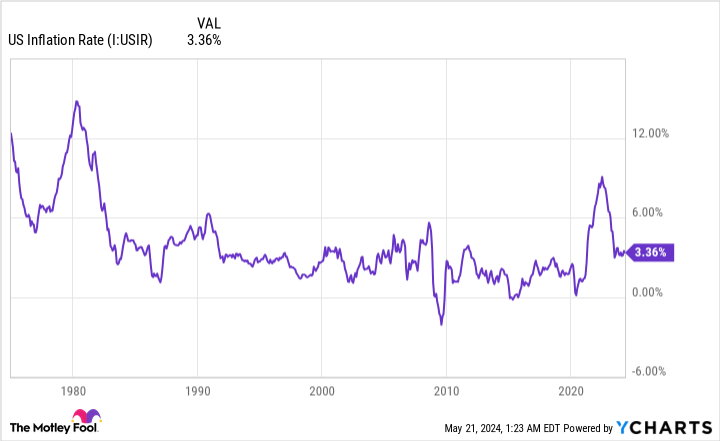For most current retirees, Social Security provides an income they simply couldn’t live without. A 2023 survey from national pollster Gallup found that 88% of retirees lean on their Social Security benefits as a “major” or “minor” source of income.
Considering how important Social Security income has been to the financial well-being of seniors for decades, it should come as no surprise that the Annual Cost of Living Adjustment (COLA), to be unveiled the second week of October, is one of the most anticipated. announcements per year.
But if the April Bureau of Labor Statistics (BLS) inflation report is indicative of things to come, a double-edged sword awaits Social Security’s nearly 51 million retired beneficiaries in 2025.

What is the purpose of the Social Security Cost of Living Adjustment (COLA) and how is it calculated?
The Social Security cost of living adjustment is the mechanism used by the Social Security Administration (SSA) to adjust benefits for inflation. Simply put, if the cost of the goods and services seniors buy increases, in a perfect world, Social Security benefits would have to increase by the same percentage to ensure no loss of purchasing power. The program’s COLA is tasked with keeping benefits in line with the inflation that recipients face.
From the time the first Social Security check was sent in January 1940 through 1974, COLAs were completely arbitrary and determined by special sessions of Congress. Only eleven benefit increases were made during this period, with no adjustments made throughout the 1940s.
From 1975 onwards, the Consumer Price Index for Urban Wage Earners and White-collar Workers (CPI-W) was installed as the annual inflation measure of social security. It contains more than half a dozen major spending categories and many subcategories, each with their own respective weightings. These weights allow the CPI-W to be reduced to a single figure each month, allowing lightning-fast month-to-month and year-to-year comparisons to decipher which direction prices are heading.
The interesting quirk in calculating Social Security’s COLA is that only the CPI-W measurements from the third quarter (July-September) matter. The remaining nine months of the year can help identify trends, but are not used in the calculation that determines whether or not beneficiaries will receive a larger benefit in the coming year.
If the average CPI-W value of the third quarter of the current year is higher than the average CPI-W value of the comparable quarter of the previous year, inflation has occurred and Social Security beneficiaries have received an “increase ” owed. The amount of the increase is based on the annualized percentage change in these third quarter average CPI-W values, rounded to the nearest tenth of a percent.


The forecast for Social Security’s COLA in 2025 continues to rise
While we have not yet reached the months of interest for Social Security’s COLA calculation, the BLS’s monthly inflation reports provide valuable clues as to what to expect when the SSA announces the 2025 COLA in the second week of October .
Over the past three years, cost of living adjustments of 5.9% (2022), 8.7% (2023) and 3.2% (2024) have exceeded the twenty-year average of 2.6%. The beneficiaries are crossing their fingers and hoping that this pattern will continue for the fourth consecutive year. While this seemed very Just a few months ago, the April inflation report from the BLS is still unlikely to suggest COLA is on the rise for 2025.
Thanks to persistently high core inflation, which excludes changes in food and energy costs, April’s CPI-W rose 3.4% over the past 12 months. That’s well above the Federal Reserve’s long-term inflation target of 2%.
In mid-January, the nonpartisan senior advocacy group The Senior Citizens League (TSCL) published a long-term COLA forecast for 2025 of just 1.4%. But following the BLS inflation reports for January, March and April, TSCL’s long-term COLA forecast for 2025 has increased to 1.75%, 2.6% and 2.66% respectively (which would be rounded to 2.7%). Based on TSCL’s projections, the expected COLA in 2025 has nearly doubled in four months and is currently on track to be slightly above the 20-year average.
If TSCL’s forecast proves accurate, a 2.7% COLA in 2025 would increase benefit checks for the average retired worker by about $52 per month.
For the average worker with a disability and the average survivor beneficiary, monthly payouts are expected to increase by $42 and $41, respectively.


Social Security’s 2025 COLA is becoming a double-edged sword for retirees
On paper, the prospect of Social Security benefits rising by more than the 20-year average for the fourth year in a row probably sounds great. The problem lies in how the program can achieve this feat.
As noted, the prevailing inflation rate remains above the central bank’s long-term target of 2% due to persistently high core inflation. More specifically, shelter inflation (‘shelter’ takes into account the cost of rent (including utilities), as well as the estimated cost of renting an owned home, without utilities (i.e. the owners’ equivalent rent))) was at 5.5% on an annual basis. unadjusted annual basis for the consumer price index for all urban consumers (CPI-U). The CPI-U is a similar inflation measure to the CPI-W.
Meanwhile, medical care inflation has been steadily rising and now stands at 2.7% over the past twelve months for the CPI-U.
Why bring up shelter and medical care when there are a number of other prominent spending categories? The answer is that a higher percentage of seniors’ budgets are spent on housing and medical care than for the average working-age American. Although Social Security beneficiaries may qualify for a new above-average COLA in 2025, the categories driving this increase are experiencing inflationary pressures equal to, or well above, the expected “increase” that retirees could receive.
In other words, there is a very good chance that seniors will experience a loss of purchasing power as the categories that matter most to them experience price increases that are even faster than the expected cost of living adjustment in 2025.
Retirees losing their purchasing power is nothing new. A May 2023 report from TSCL notes that the purchasing power of a Social Security dollar fell 36% between January 2000 and February 2023. Based on data from the April inflation report, an unfortunate continuation of this pattern seems appropriate.
Which stocks should you add to your retirement portfolio?
The analyst team at Motley Fool Stock Advisor just identified what they believe to be the 10 best stocks for investors to buy now. The ten stocks that made the cut could deliver monster returns in the coming years, potentially setting you up for a more prosperous retirement.
Just think when Nvidia made this list on April 15, 2005… if you had invested $1,000 at the time of our recommendation, you would have $652,342!*
Stock Advisor provides investors with an easy-to-follow blueprint for success, including portfolio building guidance, regular analyst updates, and two new stock picks per month. The Stock Advisor service has more than quadrupled the return of the S&P 500 since 2002*.
View the 10 stocks »
The Motley Fool has a disclosure policy.
April’s inflation report is a double-edged sword for Social Security’s 2025 cost-of-living adjustment (COLA) originally published by The Motley Fool




